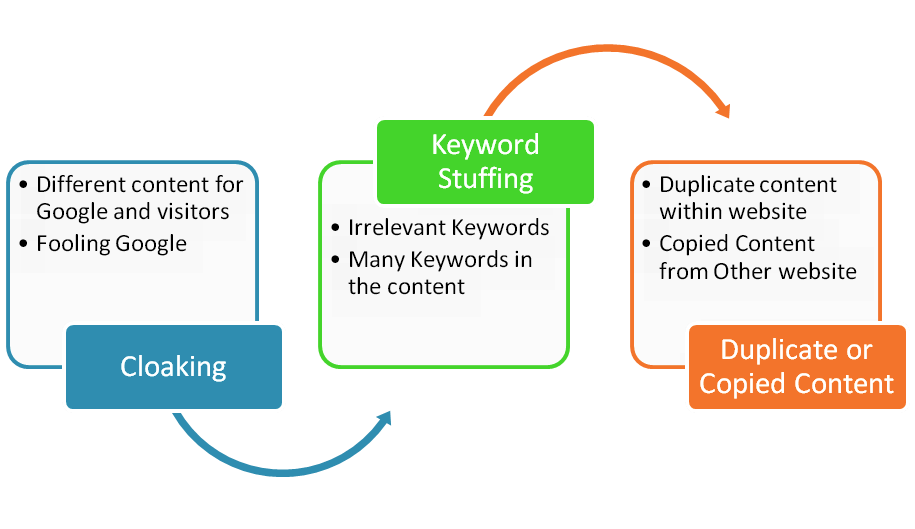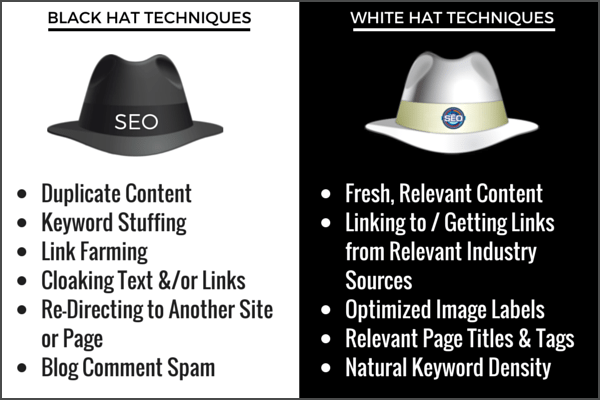Black Hat SEO – A mystery explained!
- November 18, 2018
Regardless of the sector or niche that you are operating in, ranking high in Google’s results is vital for kick-starting your project and getting more eyeballs on it. In fact, the traffic that can be generated from a high SERP position exceeds anything that you can get with advertising and other paid promotion strategies. The lure of concentrated and organic traffic has given birth to an entire industry concerned with deciphering Google’s algorithms and coming up with strategies that can take advantage of them. Early on in the life of a project, every marketer will have to make a choice between two SEO strategies; the white hat tactics that will keep them on Google’s good side, and the black hat methods that could put the entire project in jeopardy.
The definition of Black Hat SEO
Black hat SEO refers to the wide range of illicit tactics that are used by marketers in order to boost a site’s position in the search engine results pages. While these strategies might prove to be effective in the short run, it is essential to note that they are very risky and that the chances of escaping Google’s banhammer are extremely slim. Still, a significant number of novice marketers continue to make the mistake of relying on these shady tactics, and the end result is more often than not a combination of utter disappointment and regret.
Some of the most common Black Hat SEO techniques
Keyword stuffing
This technique revolves around making heavy use of keywords in the page’s Meta tags, primary content, and backlink anchors. This is done in an attempt to obtain high rankings for a set of keywords that add little to no value to the actual content of the page.
Spun content
Content spinning is a surefire way to draw the ire of Google. As the name suggests, a spun article refers to any piece of content that is automatically generated from a pre-existing article. Some marketers resort to this technique when they are in urgent need of new and unique content on their site. Google’s new algorithms are extremely adept at identifying this type of articles.
Cloaking
Cloaking is often associated with low-quality spam websites. In essence, this technique allows these sites to maintain the appearance of relevance to the Google bots, all while showing their users spammy content that is not relevant to what the site is trying to rank for. This is achieved by serving content based on the IP or User-Agent HTTP header of the user visiting the page.
PBN links
A private blog network is a group of websites whose sole purpose is to pass link juice to other sites. In order for this strategy to work, the owner of the PBN has to make sure that no digital footprints are left during the creation and managing of the network. One slip-up is all it takes for Google to establish a link between these sites, which in turn will result in a mass de-indexation of all the pages and websites that are associated with the PBN. Here are some of the missteps that can expose a blog network:
- Using a previously-penalized domain name
- Hosting multiple sites on the same physical machine
- Low-quality content
- Repeated linking patterns
Link farms
Link farms share the same underlying concept of private blog networks. The main distinction is that farms tend to be much more rudimentary in their design and the quality of their content is often extremely low. Unlike PBNs, their digital footprints are easily traceable by Google. Needless to say, their use is strongly discouraged.

The reasons why you should refrain from using black hat SEO tactics
In the past, black hat SEO tactics were so common that even established names such as Forbes and J.C. Penney were using them to boost their rankings. The reason for this lies in the fact that the line between white hat and black hat SEO was fairly blurred at the time. The lack of a comprehensive set of guidelines coupled with the relative simplicity of the early algorithms used by Google led to the creation of an “anything goes “wild-wild-west environment where players were constantly trying to outdo each other when it comes to leveraging the various factors that contribute to increasing a website’s position in the front page of Google.
Over the past few years, however, Google’s ability to identify these strategies and unearth the shady websites that are using them has become near-flawless. Gone are the days when you could get away with relentless spamming just to obtain backlinks for a low-quality website with thin content. Nowadays, Google bots are powered by extremely sophisticated algorithms that are very hard to circumvent. At a time when the most experienced black hat SEO experts are having trouble keeping their heads above water, a beginner is better served staying clear of these illicit techniques all together.
The main risk that is associated with black hat SEO is its inherent incompatibility with long-term projects. Legitimate businesses that are destined to last should always be built on a solid foundation and on a sound and concise strategy that does not come with the looming specter of de-indexation. Unless you are planning on creating a pump-and-dump site, white hat SEO is the way to go.

The white hat best practices that can help you avoid a Google penalty
Just because you are not consciously trying to game the system, it doesn’t mean that you don’t run the risk of inadvertently violating some of the google’s webmaster guidelines. To stay on the side of caution, there are several practices that you should implement in order to secure your site’s standing with Google.
- Focusing on quality content:You might have heard of the saying “Content is king”. This is especially true for SEO. Nothing can boost the legitimacy of your site in the eyes of Google than well-crafted and unique content that is relevant to the niche and keywords that you are trying to rank for.
- User experience should be a top priority:The way visitors experience your site is an extremely critical factor that has a direct impact on SEO. Creating easy-to-navigate pages and filling the site with relevant information is an effective way to reduce bounce rate, a metric that has become increasingly important in recent years.
- Keeping keyword frequency to a reasonable minimum: Google’s new algorithms have the ability to assess the contextual relevance of your content without the help of multiple keywords. While it wouldn’t be wise to completely avoid using them, you need to make sure to include your keywords in a natural way that fits the flow of the content.
- The importance of White Hat backlinks: Obtaining backlinks in an organic manner should form the backbone of your SEO strategy. Reach out to blogs and authority sites in your niche and offer to craft a high-quality piece of content that would be of interest to their audience. This will not only give your site an immediate traffic boost, but it will also pass a substantial amount of link juice to your page without spending a dime or breaking a rule from the webmaster guideline.
- Keeping up with guidelines updates: The SEO landscape is constantly changing; what used to be an effective tactic 5 years ago might be completely obsolete today, and what used to be a tolerated technique a year ago might have become against Google’s webmaster guidelines today. Make a habit out of checking the guidelines of various search engines if you want to avoid any unpleasant surprise down the line.
- Making your website mobile-friendly: Unless you have been living under a rock for the past five years, you are probably aware that internet usage on mobile devices has surpassed usage on desktops. As a response to this shift, Google has not only decided to prioritize websites that are well optimized for mobile, it has, in fact, begun penalizing the rankings of pages that were deemed not mobile-friendly.
- Including images and video: Google loves multimedia content. Armed with that knowledge, you need to make sure that your website features a wide assortment of image and video content that adds value to the user. Pages that are devoid of any multimedia content are likely to get low authority scores from Google.
Black hat SEO tactics might seem appealing to a novice marketer who is eager to climb the Google rankings as quickly as possible. After all, who doesn’t like immediate results? However, the reality of the matter is that SEO can be quite arduous and it should be view more like a marathon than a sprint. A sound strategy requires a significant amount of patience, long-term planning and often involves a number of variables and moving parts that are rarely taken into account by black hat marketers. Getting to the coveted first spot can only be achieved on a solid foundation, and the only way to build it is through white hat SEO.
MARKETING CONSULTATION
One of our experts is online, she will get back to you

Tanya Mendes
Marketing Manager


